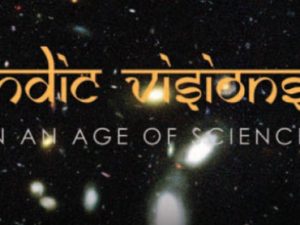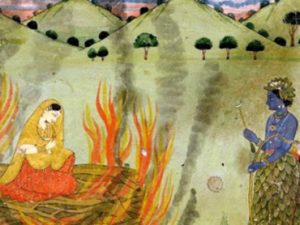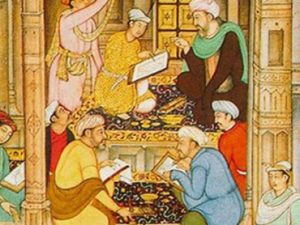Mythos: Origins and Ends
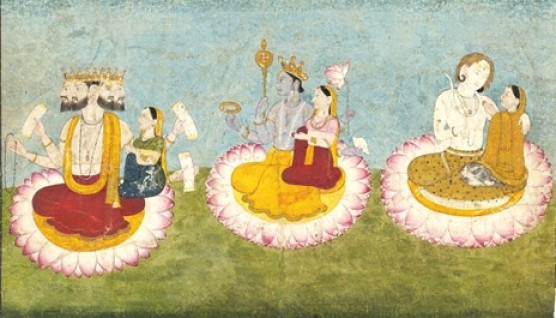
Buy online through Amazon:
Indic Visions in an Age of Science by Varadaraja V. Raman
(New York, NY: Metanexus, 2011).
or
Download the book for free as a PDF.
Introduction
Questions related to origins are among the most intriguing ones that taunt the human mind. How did we humans come to be? What is the origin of the physical world in which we find ourselves as conscious entities for a few decades? Why did we emerge at all? Equally perplexing are questions relating to the eventual destiny of individual human beings. What happens to our consciousnesses once our physical bodies cease to function? One may also wonder about what will happen to the earth and the stars and to the world at large in the very long run.
Human minds in every culture have been grappling with questions of origins and ends since time immemorial. The religious traditions of the human family have provided various answers to them.
Traditional narratives on creation
Traditional creation stories may be considered from three different perspectives: They may be regarded as revelations of how all this came to be, revelations to the prophets and sage-poets of various religions who have proclaimed the truths such as they are. Or, they may be taken as profound truths on these matters hidden behind the veil of symbolic poetry, presented in ways that are more easily grasped. Finally, they could be taken as ancient attempts by keen minds to account for the puzzling and fascinating questions challenging us.
Originators forgotten
In the various cultures of the world, different views of cosmogenesis came to dominate the collective consciousness of the people. Like the inventor of the wheel, the names of the originators of the mythopoesy of cosmogonies have dissolved in the haze of prehistory. Their names may never again been known.
Some modern names
By that very fact, it would seem, their visions have acquired an immortality that eluded Thales and Aryabhatta, Kant, and LemaÓtre. Whereas the cosmologies with which the names of these mortals are associated have been debated, accepted, and discarded with the passage of time, those of the more ancient and authorless ones persist in their venerated status as divine revelations. The less we know about who propounded a view of the beyond, about its how and when, the more firmly it tends to be engraved in the collective consciousness of cultures.
Traditional views last longer
Traditional views on cosmogony such as the Book of Genesis and Creation by Brahma have acquired a sanctity that the works of Pythagoras, Newton, and Chandrasekhar can never aspire to. It is as if the ideas of the anonymous ancients seeped surreptitiously into the collective psyche of the community. When there is no one to be challenged, others of the group repeat what they have been told, or interpret the same when times change. Thus were formed the traditional religious beliefs on cosmogenesis, sprouting out of nowhere, as it were, and taking deep root in the language and lore of people. When years rolled by, then decades and centuries, the images became ever more indelible, acquiring with time a protective sacredness that guards them from iconoclastic onslaughts. They persist as the real in the mind and manners of cultures.
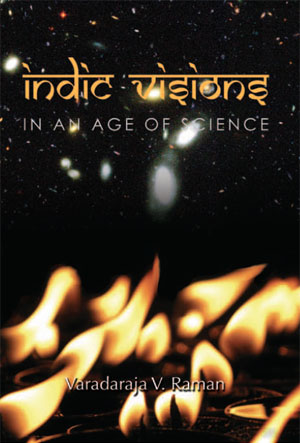 Reality of mythic visions
Reality of mythic visions
Ancient visions may seem to be fantasy to those not of the tradition, or who have been transformed by modern science. But they are and were not regarded as concoctions of the mind, either by the elders or by the common folk of traditional communities. Rather, to them these are authentic descriptions of how it had happened. In ages past, and in many places still, those who listened to the sacred narratives received them as seriously as students in science courses have been taking ‘Cartesian vortices’, ‘Laplacian nebulae’, Gamow’s ‘Big Bang’ story and Hoyle’s ‘Steady State’ picture about the universe.
Reactions of moderns to scientific theories
In our own times, the majority of the educated public who read an article in Scientific American or a book by Stephen Hawking tend to trust what the experts say, irrespective of whether they understand the reasoning and the data on which the theories rest, imagining that the truth has at last been enunciated by the scientific establishment. It is important to remember that scientific theories of cosmic birth have risen and fallen like children’s castles on sandy shores. New scientific theories about origins keep coming and going on the basis of newly acquired data and new insights of investigators. The difference between the modern scientific modeling and pre-scientific visions lies, not in which is real and which is not, but in the awareness of reflecting scientists that for all its sturdy factual foundation, the scientific imagery has a finite probability that it will be modified or overthrown in due course.
Thus, whereas religious answers to fundamental origin questions vary from place to place, the answers given by science vary from time to time. Put differently, scientific answers are culture invariant but time variant, whereas religious answers are time invariant, but culture variant.
Frameworks of religious view: Centrality of humans
The thesis of the religious view is that human beings play a central role as a purported end-product, i.e. as the intended goal of Creation. From the religious perspective, the will and guidance of an omnipotent and omniscient Creator has always been there throughout the history of the world. Earthlings for whom all this was made can still invoke the Creator in times of joy or need, pain or panic, and their prayers will be answered. This worldview is very different from the framework of science in which mathematically precise laws operate without pause or exception to keep the universe rolling in time.
Existence of Good and Bad
Another important feature of most religious traditions is that there exist moral principles in the universe, forces of Good and Evil, and that ultimately Good will triumph over Evil. There are no such principles in modern science. It should be pointed out, however, that a great many scientists of the past, whether the Aryabhatas and the Bhaskaras of the Hindu world, or the Keplers and the Newtons of the Western world, were deeply religious and believed in a Divine Being, and many modern scientists still are persons of faith. One reason for this is that no matter what our scientific paradigms may be about cosmogenesis, we get no guidance from science as to what is right and wrong, good and bad. Furthermore, to many people religions also provide a different kind of fulfillment that science does not.
Current scientific paradigm
In the current scientific paradigm, the universe stumbled into existence on its own, because of some mishap in a silent and latent symmetry, intelligible only to those initiated into the mathematics of group theory and high energy physics. It was born from a point singularity with a bang that was truly big, spewing out matter and radiation every which way, creating space and time in the process. The cosmology of today’s physics suggests that the gestation period for the universe was inconceivably small. In a fantastically infinitesimal interval of time, known as the Planck time which spans the ‘Grand Unified Theory’ or GUT era – there was a major splitting of a unified field into two: the gravitational and another. In this picture, the density of the universe was infinity to begin with, because all its mass was concentrated in zero volume. After the Planck-time, during a millisecond the universe grew to the size of a mini-marble, then the whole thing expanded to about 1030 times its size. In the meanwhile, there was further separation of force fields into what we call the gravitational, the strong, the weak, and the electromagnetic. As a result of the co-nascent laws of nature and the fundamental interactions, matter and radiant energy such as we know them came to be. Then, in the course of a few billion years, stars and planets were slowly formed by gravitational enticements, heavy elements were synthesized in the crushed core of super-hot supernovas, and so on.
Cosmogenesis: Vedic vision
In the Rig Veda there are visions of how the world came to be. The best known of these is in the Nasadiya or ‘Creation Hymn’ . This is one of the most sublime expressions of Cosmic Creation in all of human legacy, and is certainly one of the most sophisticated poetic reflections on how this magnificent universe could have emerged.
One may consider the Nasadiya sukta from different perspectives. The first, which certainly illumined the spirit of its author, is mystical. The hymn is a deeply experiential outpouring: a mystic’s rhetorical response to the grandest mystery of all: existence and transformation, being and becoming. Such an articulation is to be felt, not analyzed; shared, not dissected.
Another approach is to regard the hymn as a visionary poet’s reflections and composition. When we read it in English, it is difficult to resonate fully with the divine chords that ring in the hymn, as it were. But a translation can still give us a glimpse of the vision that the work conveys. It is with this awareness of the limitation of the intellect in the face of Vedic mythopoesy that I will consider the Nasadiya.
What strikes us in this piece is that the sage-poet speaks of a pre-creation stage with nothing in the universe. This is a remarkable vision of the pre-big-bang phase. That unimaginable phase is described as an eerie nothing where there was no air or heaven. By referring to air and heaven, the poet tells us that there was neither the subtlest matter of any kind, nor the most lofty thought of any kind, for ultimately the perceived universe is pervaded by things and thoughts. Then the poet conveys his wonderment about who might have encapsulated such an awesome void, and where in the world it could have been when there was no where at all in the world. And what about the ubiquitous life-giving water that covers so much of the world? Was it there, the sage-poet wonders, as if to say how could life have emerged when its very substratum was not there to begin with.
He goes on to reflect on other features of the perceived world, such as decay and deathlessness, and the routine rhythm of day and night. If anything was there in such colossal emptiness, it must have existed all by itself. If it was dark, it must have been embedded in utter darkness also, a darkness which must have been as in the abyss of obscurity in the depths of the sea. For the entire universe to emerge from it all, there must have been unbounded energy. Modern cosmology speaks of no original energy whence it all came. The Vedic poet postulates that the universe must have come about from an innate spiritual energy. He refers to it as tapas.
Then comes an meaningful imagery which touches our core: there was a deep desire on the part of something to manifest itself and that the first seed of creation must have germinated in a cosmic mind. When the sage-poet suggests that desire found its way into the utter void, we may take it to mean that the universe, to be born, must have a purpose, for it is hard to envision how such grandeur and splendor could arise for no reason at all.
Thus we are reminded that whatever we see as tangible in this world is ultimately intertwined with the intangible non-existent principle. This line contains the central core of Hindu thought about the nature of the world and how human consciousness should recognize it. It expresses the interconnection between the sensory world of crass matter and the insubstantial under girding reality which is non-existent as a tangible entity. There can be no world such as we know without thought. The universe is not a stack of paper with random scribbles scratched on every page. It is rather like a beautifully bound volume with poetry and plays, essays and stories spelled on its countless reams, for that is what the laws of the physical world are. The creation hymn goes on to say that cosmic forces were unleashed up there in the skies and down here on earth. Thus did creation come to be, and there arose more creative principles for the sub-elements in the universe.
Then, suddenly, intellect jolts the mystic, and the sage-poet wonders if those awesome images of a grandiose nothingness, of the primordial desire and of seed-sowers that gushed through his vision were all really there. Or was it perhaps only the dreamy delusions of a speculating mind? He is not sure. He is not even sure the primal creator of it all has answers to his questions. The mystic turns into a thinker now, and he reminds us that when it comes to origins, not even the best among us can be cock-sure of what we imagine to be the truth.
What is remarkable in this narration is the terse comment that “Even gods came after creation’s day.” In this Vedic reflection on Genesis, which is one of the most ancient of its kind, we find a disarming modesty, for the sage-poet also exclaims, “Who really knows, and who can swear!” As we read this line, it dawns on us that it is not necessary that a religious worldview will have to be uncompromisingly. This is a skeptical attitude that is truly commendable from a scientific perspective. At the same time, it is also an expression of enlightened humility, and the admission of genuine bewilderment in the face of what is the grandest mystery: The how and the why of cosmogenesis. As long as there is mystery there will be religion in the best sense of the term. As soon as the mystery is unmasked by an answer, there will be dogma, not religion any more.
In the matter of cosmogenesis, Hinduism is unique in two ways. First, its most sacred scripture expresses a tentativeness in its version of origins. This is in glaring contrast to the emphatic affirmations that we find in other religious traditions. Herein lies the key to an understanding of the doctrinal tolerance that is built into the Hindu mode of responding to ultimate questions. This is why it is easier for a Hindu to pay homage to the religious tradition of other religions than it is for the faithful of other traditions to feel an oneness with a tradition that is not their own. Here is something the modern multicultural world can learn from ancient wisdom.
No religious text in all the scriptural volumes ever composed adopted such an posture of doubt as what we find in the Nasadiya of the Indic tradition. More significantly, these lines remind us that experiential truths of mystic visions melt away into doubt and uncertainty when one reverts to the world of logic and reason.
Nasadiya: Hymn of Creation
Not even nothing existed then, No air yet, and no heaven.
Who encased and kept it where? Was water in the darkness there?
Neither deathlessness nor decay, Nor the rhythm of night and day:
The self-existent, with breath sans air: That, and that alone was there.
Darkness was in darkness found, Like light-less water all around.
One emerged, with nothing on, It was from tapas that this was born.
In it did Desire, its way did find: The primordial seed born of mind.
Sages know deep in the heart: What exists is kin to what does not.
Across the void the cord was thrown, The place of every thing was known.
Seed-sowers and powers now came by, Impulse below and force on high.
Who really knows, and who can swear, How creation arose, when or where!
Even gods came after creation’s day, Who really knows, who can truly say
When and how did creation start? Did He do it? Or did He not?
Only He up there knows, maybe; Or perhaps, not even He.
Other Hindu visions of cosmogenesis
The Hindu response to fundamental questions about origins is also unique in that it presents more than one view of cosmogenesis. In another Vedic hymn, a second view as to how the universe began is given by means of a metaphor. Here the poet pictures the world as having emerged from the cosmic womb. For so magnificent an entity as the universe, the generating womb had to be grand and glorious and golden, the visionary felt. Thus, the Vedic sage described it as Hiranyagarbhaor ‘the golden embryo’. Hiranyagarbha is also personified as lord of the mountains and of the seas. The magnificent sky and the earth and the sun came from him. It was Hiranyagarbha who gave life and strength, and gods obey him. Both death and immortality are his shadows.
So the poet glorifies the primordial principle whence everything emerged, repeating that we should worship Him with oblation. In this imagery, we see an integration of science, poetry and religion. It is science in that it offers an explanation as to how it all came to be; it is poetry in that the explanation is clothed in a visual imagery; and it is religious in that there is a recurring line that we should worship the source of it all. All this reminds that we should seek to understand, appreciate and also express our gratitude for this experience of life in a world that is stupendous and splendid in countless ways.
Metaphoric versus literal interpretation
The idea of the Golden Embryo need not be taken literally. We may look upon it as a metaphorical view of the universe emerging from a central core. But mythic tales swelled in Puranic narratives in due course, extending to inhabitants in various realms of the universe, conflicts among and between extra-terrestrials, their defeats and victories, and other fascinating tales. In other words, insightful hypothesizing gradually metamorphosed into what reads like science fiction created by unbridled imagination.
Yet, visions of other beings existing in other realms are not very different, conceptually speaking, from what current exobiology envisions: namely, the existence in other planetary systems of intelligent life-forms, perhaps in highly advanced states of civilization and with superhuman capacities.
Mundaka Upanishad: Spider-web analogy
The Mundaka Upanishad says that the creator Brahma Himself arose as “the first among the gods, and as the creator of all.” If we regard Brahma as the 26 or so dimensions of modern M-theory, and gods as the laws of physics sustaining the universe, this statement in the Mundaka Upanishad is a poetic formulation of the current paradigm. In a famous passage, it also gives a beautiful simile for how the universe arose:
“As the spider generates, and draws in (its filaments), as the herbs grow from the ground. and hair from the body and head of a living man, so from the imperishable, the universe springs.”
The filaments of the spider refer to the creation of something from a central source, and its withdrawal into where it came from; the herbs refer to life, and the hair from the body brings home the idea that the created elements are spread all over. Just as the jargon of modern physics is utterly unintelligible in its mathematical opaqueness, mythopoesy often hides visions of significance behind simplistic tales.
Notion of circular time
Hindu thinkers developed a theory of time flow, by which the hatching of the cosmic egg and its subdivision into various sectors is a periodic recurrence. In this picture, the physical universe, such as it is, will change, evolve, and eventually dissolve into nothingness once again, retracting to its original phase. In modern scientific imagery, this would be like zooming back into the initial black-hole singularity, only to re-emerge and repeat the process all over again. This is the oscillating universe model.
When this concept was formulated in the epics and sacred histories in terms that are intelligible to the lay person, they became the four yugas: long periods of time of unequal duration. As per this reckoning, we are currently in the fourth yuga, known as the Kali Yuga, which is said to have begun some five thousand years ago, and is expected to last for 432,000 years. The total period of time forming all the four yugas adds up to 4,320,000 years. This is the Mahayuga or Great Yuga. A thousand Mahayuga make up a half day in the life of the Cosmic Creator. A full day or Kalpa for the Creator is 8.64 billion years. This cycle is said to go on endlessly, each manifested phase and its inert counterpart lasting together so many billion years.
The yuga-idea introduces the notion of a circular time, for according to it, there is a cyclic repetition of events in the universe. The idea is very interesting as a concept in that it is an extraordinary leap to theorize about the cyclic nature of cosmic time, and also because it is counter-intuitive. In the modern scientific world, it was only after the development of statistical mechanics in the later half of the 19th century that the idea of this kind of recurrence was brought in. Only after the discovery of an expanding universe, and its theoretical connection with general relativity did the idea of a contracting universe, and a possible oscillating model emerge, reminding us of the repeating cycle of ancient Hindu thinkers.
Notion of linear time
Then again, the notion of time, both in other traditions and in modern science had always been unidirectional, always advancing, with never a return to an initial state.
No culture aside from the Indic even fantasized such humungous time periods when talking about the universe. Others had spoken only in terms of a few thousand years at most. In the 18th and early 19th centuries, fossils were estimated to be a few million years old. Even 19th century physics had no context in which to speak of time periods of the order of billions of years. In the latter half of that century, Lord Kelvin spoke of the age of the sun as being of the order of a few million years. It was only after the discovery of radioactivity and the half-lives of radioactive elements that one was forced to think in terms of billions of years
The enormity of time spans envisaged in the ancient yuga paradigm is absolutely mind-boggling. In this context, Dr. Gopala Rao asked rhetorically in one of his papers on Hindu cosmology, “How did the ancients come up with cosmological time scales that are so closely in agreement with modern ones? Did they have access to ways of knowing in the remote past that we cannot figure out? Were such ways lost due to some global catastrophe?” It is tempting to suspect that the ancient Hindus were familiar with the reckonings of modern cosmology which also estimates the age of the present universe to be of the order of ten and odd billion years.
Oscillating universe model
Hindu thinkers were the first to have envisaged a recurring universe. The Yuga cycle handles one of the most difficult conceptual quandaries: the origin and end of time. The Big Bang model, with all its merits, fails to explain why the universe occurred at all at some point in conceptual time, marking the beginning of physical time. Nor does it cope well with the asymmetry of time having a zero-point origin and no end-point at all. It is like a number system without negative integers. The Yuga notion cleverly resolves this impasse by postulating that the cycle rolls on and on, without beginning, and without end.
Future of humankind
Another intriguing question relates to the future, what will happen eventually to individuals, to humanity, and to the world? Religions declare that our fates will be determined by our behavior. This makes no difference for science, given that in its view, with the ceasing of physiological functions, individual consciousness also ends.
In the Hindu worldview there are metaphysical laws for the transition of the soul. This is the karma principle by which every conscious act that has an impact on others will have a consequence on the acting principle. Associated with this is the cycle of birth and death. Rebirth is inevitable for those who have engaged in consequential deeds.
Ultimate merger
In the Hindu spiritual framework, when one has completely acquitted oneself of the debts that have been incurred through karma, one attains mokhsa or complete spiritual liberation. This refers to the merging of the individual consciousness with the Cosmic Consciousness from which we all have sprung.
Eventual state: The Shiva Principle
Physical science tells us that in the very distant future, when all the stars would have spent away their energies, the world would come to a sordid heat-death where entropy would have attained its maximum value. In the Hindu vision, there is a cosmic principle of dissolution that will cause everything to cease. It is known as the ‘Shiva principle’. I twill bring to naught all that has emerged. Not just the short-lived bloom of a rose and the steady heartbeat of a healthy human, but everything ultimately will come to a dead end. From the frail whisper of the gentle breeze to the sturdiest of rocks, from the mute interactions of leptons and hadrons to the seemingly endless existence of spectacular galaxies, everything is destined ultimately to vanish. This is the Shiva mystery of the Hindu vision. It is the dot that completes every sentence of existence, the last breath that lulls the lungs, the invisible rope that closes the curtain at the end of the cosmic show, the ultimate sigh of the grand universe itself, the Omega point of the Cosmos.
The Why of the Universe: The Lila hypothesis
The question now is: Why did it all this happen? Why did Brahman choose to manifest itself?. It is beyond the scope of science to answer this. Any answer to this question will have to be poetic or theological. As the poet said millennia ago, perhaps not even the gods know. But we may conjure up theories as to why this could have happened.
Some Hindu thinkers suggested that all of creation is nothing but the play of the Divine. This theory is known as Advaita. Simply put, the Divine was too bored with emptiness in endless time, and brought about a universe so that it could watch its evolution and be entertained. As we read a novel, the Divine is writing this grand cosmic narrative to while away time. The purpose of the universe is very simply to enable time not to be standing still all through eternity. Staring at the void made even God Almighty restless. The Creative principle is thus pictured as a Cosmic Doodler, as it were, sketching away patterns in accordance with self-prescribed principles.
In the first decades of the 20th century Johan Huizinga formulated the notion of “Homo ludens,” the playing Man in contrast to “Homosapience,” the knowing Man and “Homo faber,” the making Man. Long before him, Indic thinkers came up with the idea of “Deus ludens,” the playing God, to explain the emergence of the world.
This idea is not more, nor any less, demonstrable than any other theory conceived by the human mind to account for the why of the world, and is at least as pleasantly charming as any other.
On the question of cosmogenesis Indic vision has two things to say: It is among the grand mysteries for the human mind which can never unravel it, for some truths are beyond the reach of the analytical mind. As to purpose, creation is not to please us, but to please the Creator. On final analysis, how can we, who came only in the last few minutes into a universe that has lasted for eons, how can we be presumptuous enough to think we can find out how it all came to be. As Ramana Maharishi, echoing Socrates said:
“All metaphysical discussion is profitless unless it causes us to seek within the Self for the true reality. All controversies about creation, the nature of the universe, evolution, the purpose of God, etc., are useless. They are not conducive to our true happiness. People try to find out about things which are outside of them before they try to find out ‘Who am I?’ Only by the latter means can happiness be gained.”



